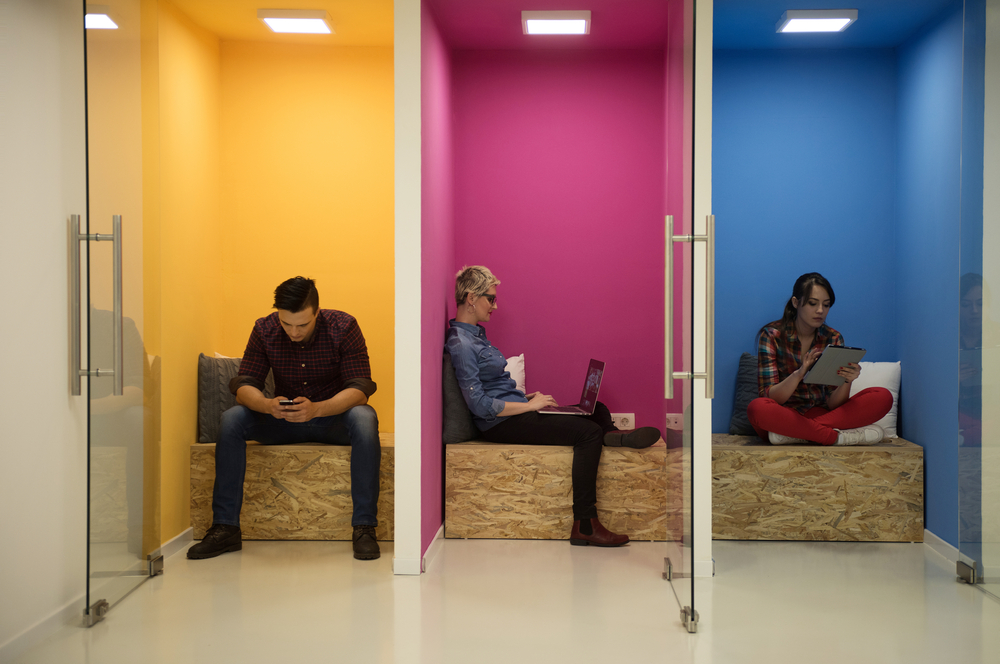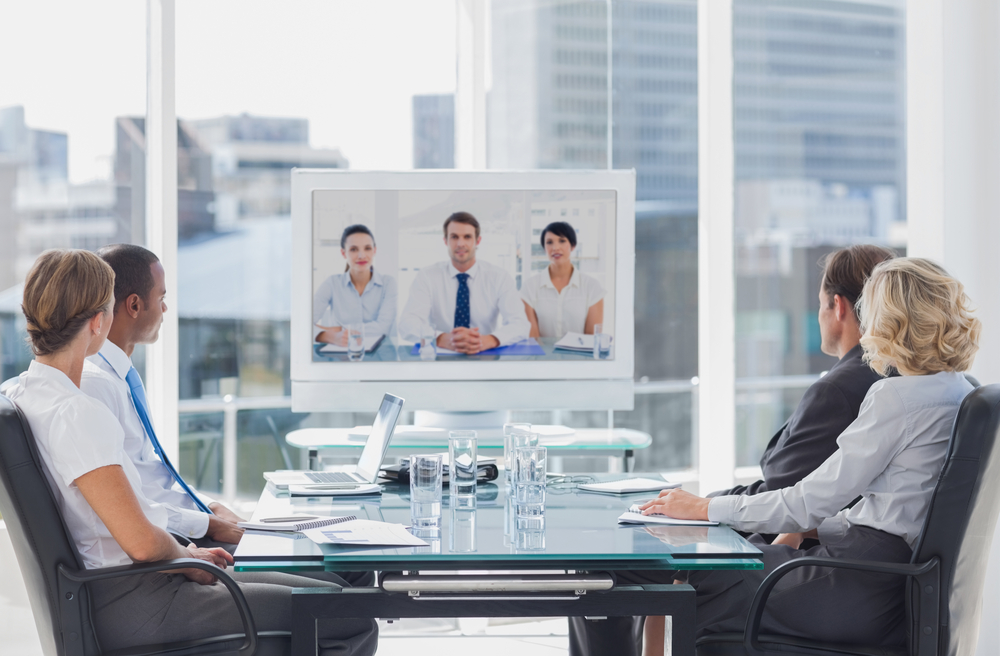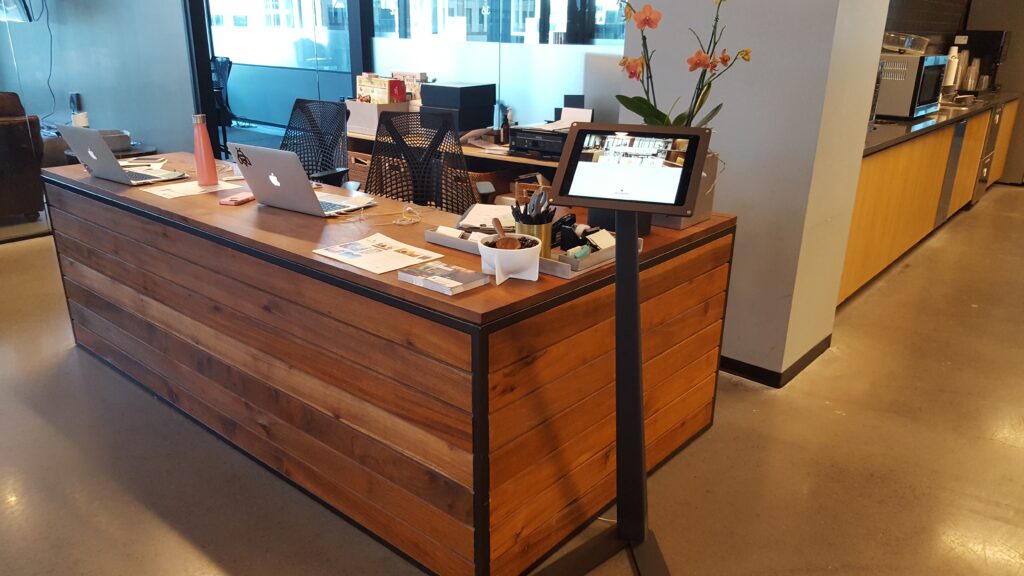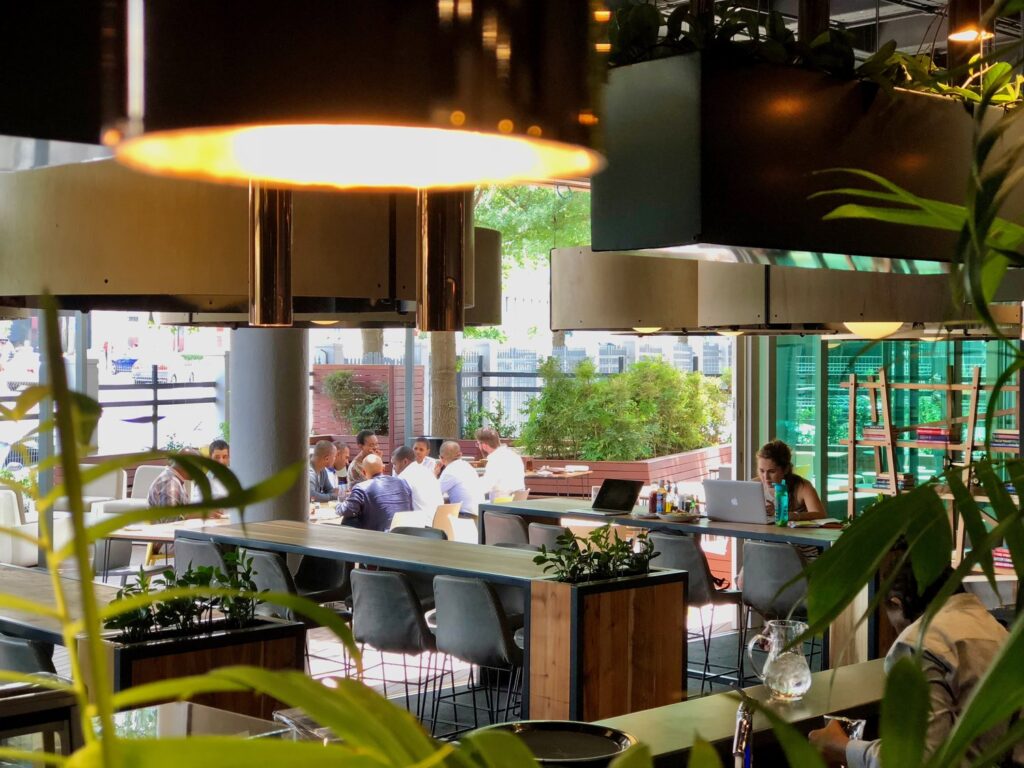The worldwide boom in coworking spaces has been fueled by many factors ranging from the increase in portable technology to the rise of the gig economy, to enterprise companies seeking space for their satellite offices and remote workers. Another trend includes more and more large companies building out their own internal coworking office area for the deliberate design that enables easy collaboration.
Coworking spaces of all kinds benefit from thinking very carefully about the designs of their offices. While some people think trendy, quirky offices might be what people want, quirky offices only work if, well, they actually work. Function matters, and it is well worth taking the time to consider good design and working with a design professional, as these factors can make or break the success of a flex office location.
Variety of Seating and Function
When it comes to flexible office space, giving members the option to choose their workspace is absolutely vital. Variety is essential to providing for the needs of different kinds of members. Some members will want space at a collaborative table, while others will need a dedicated desk or even an isolated office. Even just one member may have different needs throughout the day. Millennials, in particular, appreciate the opportunity to move around during the workday.
A great coworking space will have many of the following:
- Shared tables a.k.a. library tables, with power running down the middle
- Standing desks or standing-height tables for gathering around
- Dedicated desks with locking storage
- Coffee shop-style tables with chairs and/or sofas
- Isolated, cozy areas for relaxing and taking a break (think of Google’s famous nap pods, or maybe just a small book nook with a comfy chair)
- Offices for one, two and up to a dozen people
- Meeting spaces and conference rooms of various sizes
- Open areas for socializing during coworking events
- Rooms appropriate for workshops
A member might start their day at a library table, powering through writing an article or another high-priority task. After an hour or two, they move to the standing tables, inviting a few others to join them. Together, they end up brainstorming a solution to a problem one of them has been having while joking around. After lunch, the member attends a workshop on marketing and then meets with a colleague in one of the small offices.
Of course, it is important for any location to think of their audience when designing spaces. If a location’s goal is to attract primarily artists, studio space might be more important than offices. On the other hand, a location catering to medical personnel may require exam rooms. In an existing space, evaluating what members are using – determining which areas are in high or low demand – might help an owner understand that the beanbag chairs need to go, while more standing-height cafe tables are needed.
Lighting and Sound
Light and sound design are critical to making a space feel warm, welcoming and functional.
When it comes to light, getting natural light into as many spaces as possible should be a top priority. Access to natural light is one of the most important things a person can have to boost their well-being, while the absence of natural light can severely hurt energy levels and mood.
If a space is being designed from the ground up, this can be considered from the beginning. Retrofitting an existing space, however, may require some creativity. Offices and conference rooms containing windows should have glass walls so light can filter into adjoining spaces. To increase privacy, install textured or frosted glass in at least some spaces. Consider adding skylights or clerestory windows where appropriate.
In addition to natural light, rooms and offices need adequate task lighting to be able to write at desks, see whiteboards, and hold meetings. This is especially critical if members work well into the night, or if your space doesn’t provide adequate natural light to all areas. Some lighting to consider includes:
- Lighting over counters
- Lamps at desks
- Floor lamps near cozy areas
- Pleasant, adequate overhead lighting
Like lighting, designing a space for appropriate acoustical noise and sound transference can make a terrific difference in how functional a space is. Flex offices need to design and designate noisy areas, quiet areas and soundproof areas.
- Noisy areas are the places people gather to chat, socialize and collaborate. This is where the community is fostered, and where formal and informal collaboration happens.
- Quiet areas lend themselves to those who need to put their heads down and focus on their work. Again, think of a library. Even if ten people are working side by side, they aren’t exchanging words, or if they are, it is in low tones. If a conversation gets too involved, the participants should move to a noisy area.
- Soundproof areas might include offices, meeting rooms, and training/workshop facilities. While these areas may not be truly soundproof, sound from within should be muffled enough not to interfere with those working outside, and vice versa. Conversations within an office should stay private and should not bleed into neighboring areas. An interesting addition to some shared workspace locations may be one or more soundproof phone booths. These sound-isolating chambers provide the possibility of making a private phone call without having to use an entire office. A large soundproof booth could be used as a podcast recording studio.
Of course, other ideas should be considered based on its audience. Musicians might need soundproof studios and lights that attach to music stands. Architects might need drafting tables with attached lamps.
Access to Power & Great Technology
In this mobile world, access to power, WiFi and technology are absolutely essential. Many freelancers, remote workers and consultants rely heavily on access to the internet and cloud-based storage in order for their businesses to function. Without it, they may as well be dead in the water.
Precisely because the internet has become the hub of activity and business, the internet in a coworking space needs to be fast, reliable and everywhere. If there is a place someone can sit down within the boundaries of the space, there had better be WiFi, and even better, power. We need to recharge our laptops and smartphones even more often than we need to recharge our bodies with a good night’s sleep.
What does this mean when designing a space?
- WiFi everywhere: Make sure your wireless routers and hubs are strategically located so every location on site has access. Don’t go for minimum coverage here, as a strong signal even in the most remote corner is necessary. If someone steps outside into the courtyard, it needs to have WiFi.
- Abundant outlets and charging stations: Again, if a person can sit down in a chair, there needs to be an outlet nearby. Outlets with built-in USB chargers pull double-duty and allow everyone to plug in whenever juice gets dangerously low and threatens to halt business for the day.
- Hard-wired connections: For some folks, WiFi alone just won’t do. A hard-line internet connection usually provides faster upload and download speeds. This may be especially important for those working with a lot of graphics, sound or video files. While these connections need not be as common as WiFi and outlets, a few scattered throughout the space – especially in offices or at designated desks – could fill a need, and maybe even carry a premium price.
Other technology, while perhaps less essential to day-to-day individual businesses, can greatly streamline the process of working in a coworking space.
- Coworking space management software allows people to reserve space and pay for their memberships quickly and easily without staff intervention.
- Digital visitor check-in kiosks allow visitors to check-in at the front area and then take a seat. The software can automatically notify the member wherever they are within the building by text, email, phone or another preferred method. Once they receive the message, they can retrieve their guests.
- Electronic door locks provide the opportunity for 24/7 access to the flex space and a feeling of security. Locks can be unlocked by key cards or cell phone apps.
Amenities
When designing a flex workspace, it is important not to forget some of the extra – and maybe necessary – amenities that members are going to want or need. We’re talking about the extra touches and items that make working in a serviced office almost as convenient as working from home. (Let’s face it, staying home in PJs is probably more convenient, but the whole point of coworking is to find a social, professional place to work.)
Some basics:
- A kitchenette/break room: Members need a microwave to heat up their lunches. A coffee maker – with free coffee – is something of a necessity for a large number of people. Tables with chairs to sit and eat lunch separate from the working areas may help people unwind. An honor bar is an extra touch that makes it easy and convenient for members to grab a quick snack – and it provides an additional revenue stream for the organization as well.
- Locked storage: Members may have important files, electronics, cash, projects and other items that they would prefer to leave at the location rather than cart home every night. Individual storage lockers of various sizes and locking desk drawers provide needed security for items of this nature.
- Printers/Copiers/Scanners: We may be moving toward a paperless society, but printing is still a necessity. Members need access to a printer, copier and/or scanner somewhere on site. This can be an all-in-one unit.
- Appropriate resources: This is really dependent upon the type of audience the location draws. If it is a location for doctors or lawyers, paid access to a medical or law library database provides knowledge right at their fingertips. Entrepreneurs and startups might prefer a small nook filled with books for starting a business and the state and local laws governing licensing and the like.
While some amenities are basic needs and need not be luxurious, the sky is the limit when it comes to amenities that could be built-in to the design of the space. Here are a few luxury ideas:
- Exercise rooms with mats and/or exercise equipment
- Relaxation/meditation rooms
- A hot tub and/or endless swimming pool
- On-site childcare
Character
In the end, no one wants to work in a sterile environment (except perhaps surgeons). Once the framework and needs are considered and on the list of things to include, it is time to make the space reflect its character. Is the space quirky and fun, or professional and poised?
The design of the space, like the design of any great business space, should indicate its brand. Colors should be repeated throughout the location. Furniture should be chosen with care, both for ergonomic design and for visual appeal. The artwork on the walls, on the floors, on the shelves should be consistent and reflective of the vision of the space.
A space specifically for women could feature huge portraits of influential women on the walls. A space for entrepreneurs might reflect their spirit with bright colors and bold statement pieces. A space with a focus on the environment might choose earthy tones in greens, blues and browns, as well as useful pieces with natural materials, like wood and stone.
Summary: Design for Function and Fun
In the end, when it comes to designing for an executive suites space, the function is of the utmost importance. If the space doesn’t work for the people it is meant to serve, then something is lacking in the design. Multiple types of seating and workstations, adequate light, appropriate sound levels, technology and access to it are all absolute necessities for those working in a flex office space. Other amenities, like coffee and kitchenettes, make the place pleasant and convenient. The character of the space is the icing on the cake that brings it all together.
Your coworking location should meet the business needs of its members while providing that unique place where multiple business people can come together to bounce ideas around, create a social network, and get important work done.







